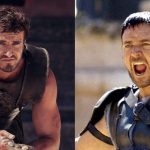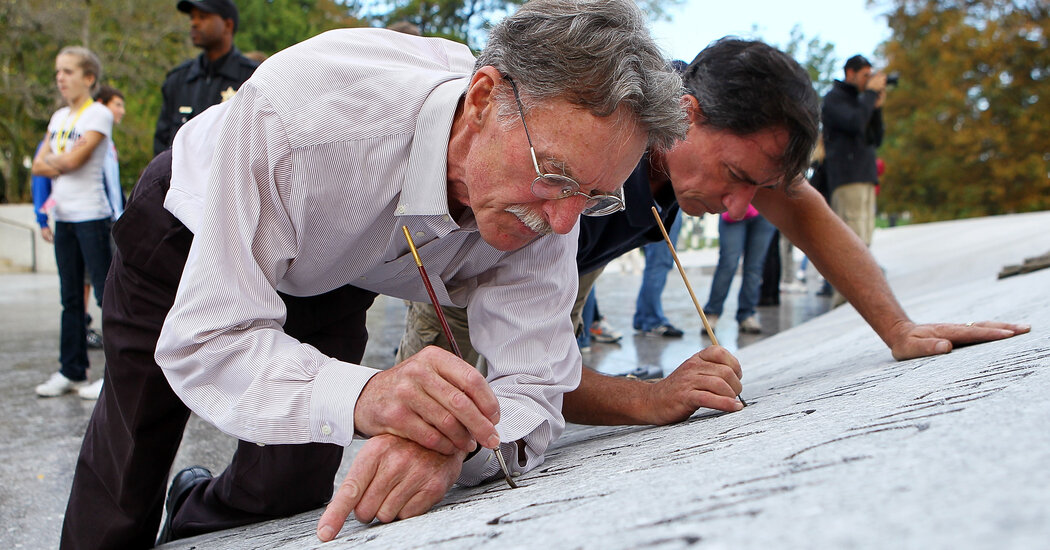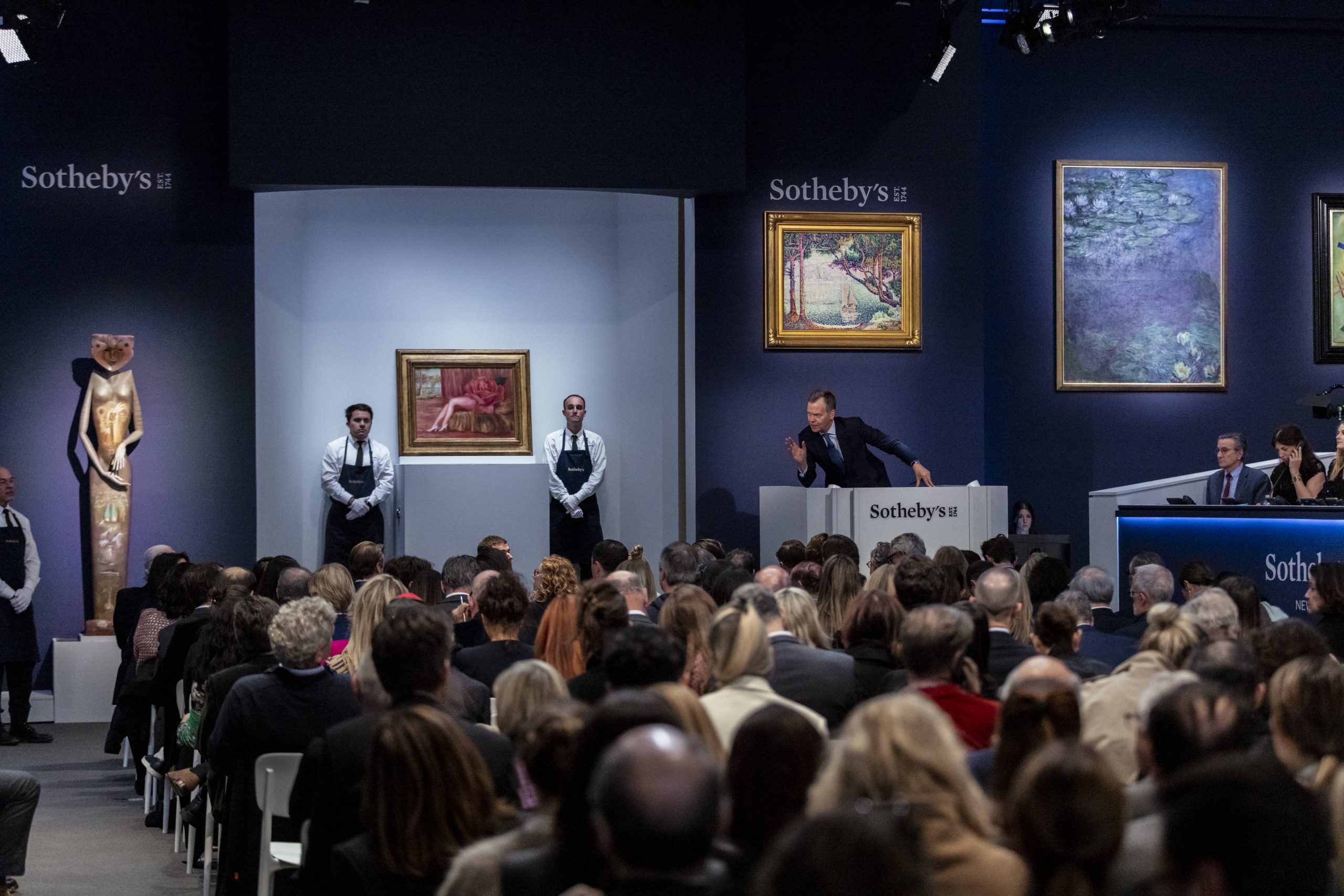John Everett Benson, a master stone carver, designer and calligrapher whose chisel marked the deaths of presidents, playwrights, authors and artists, as well as generations of American families — and whose elegant inscriptions graced museums and universities, government buildings and houses of worship — died on Thursday in Newport, R.I. He was 85.
His son Christopher said he died in a hospital but did not specify the cause.
Mr. Benson practiced the ancient and exacting art of carving into rock; slate was his preferred medium. He did so, precisely and gorgeously, on cornerstones, gravestones and monuments, as his father had before him, working out of an atelier in Newport called the John Stevens Shop. Founded in 1705, it is one of the oldest continuously run businesses in the country.
The art Mr. Benson practiced is mostly devoted to mortality, the brief span of a life, though it is designed for eternity, or something close to it. It is often described as the slowest writing in the world. Mr. Benson could spend a day carving a cross; a gravestone might take three months.
For the inscriptions for the East Building of the National Gallery in Washington, designed by I.M. Pei in the 1970s, he averaged an hour and a half carving each letter, some of which are nearly a foot tall. He and his team at the time, two young carvers named John Hegnauer and Brooke Roberts, spent months completing the painstaking work.
He carved the words on the pedestal that supports Secretariat’s statue at Belmont Park; he also carved John D. Rockefeller Jr.’s credo into a slab of polished granite in Rockefeller Center. His elegant slate alphabet stone — alphabet stones are where lapidary artists show off their chops, their calligraphic feats and flourishes — lives in Harvard’s Houghton Library. He also worked on the National Cathedral in Washington, Yale University and the Boston Public Library, among other institutions.
Mr. Benson, who was known as Fud, was 25 when began his first major commission: to mark John F. Kennedy’s grave at Arlington National Cemetery and carve selections from his speeches onto a low wall made from seven granite blocks. (He changed into clean bell bottoms when Jackie Kennedy came to the shop in Newport to approve his design.)
Stone carvers on public sites invariably draw a crowd. And, inevitably, someone will ask, “What if you make a mistake?” As Mr. Benson, Mr. Hegnauer and Mr. Roberts worked at another site, the Kennedy Center for the Performing Arts, onlookers asked and asked, so much so that Mr. Benson requested that a flyer be made to put an end to the incessant questioning.
Q: What happens if they make a mistake?
A: Don’t worry, they won’t.
“Why go to all this kind of trouble to get a name on a building?” Mr. Benson said in “Final Marks: The Art of the Carved Letter” (1979), a documentary about his work made by Frank Muhly. “Why carve it into the stone? Why carve it in this particular fashion?” He added: “There’s a tremendous emotional appeal about a carved letter. It partakes of the substance of the building. And of the carved letters, this particular style” — Mr. Benson favored what is known as a V-cut — “shows very clearly that the letter is made of the same stuff as the building itself. There are lots easier ways to do it, let me tell you.”
John Everett Benson was born on Oct. 8, 1939, in Newport, R.I., one of three children, and grew up in an 18th-century clapboard house overlooking Narragansett Bay. His mother, Esther Fisher (Smith) Benson, known as Fisher, was a Philadelphia-born Quaker who used “plain speech” at home, deploying “thee,” “thy” and “thine” for “you,” “your” and “yours.”
His father, John Howard Benson, was an artist who had become enamored of the stone carver’s art. He bought the John Stevens Shop with a $1,200 loan in 1927, when he was 26, and began to revive its business.
The elder Mr. Benson was, like his son, a polymath skilled at calligraphy and carving, and he elevated the practice, reaching back to the Roman tradition of carving large, elegant capital letters designed first with a brush and ink on paper. In his time he was known as the country’s finest stone carver, and he worked on many commissions, including the Metropolitan Museum of Art and the Rhode Island School of Design, where he was a professor.
Fud was 15 when he began apprenticing in the shop, and his first commissions were gravestones for two clients’ pets. He was 16 when his father died of a heart attack in 1956. His mother ran the business while he studied sculpture at the Rhode Island School of Design, and he took over the shop after he graduated in 1961.
Mr. Benson was eloquent, erudite and prone to grand gestures. He was agile enough to perform a Fred Astaire chair trick — stepping from seat to chair back in a graceful arc — though he sometimes overestimated his abilities. During a youthful fascination with firearms, he shot himself in the leg. He was better on the fiddle, and played traditional Irish music and sea chanteys with a local band, the Reprobates, in Newport’s bars.
In addition to his son Christopher, a painter, Mr. Benson is survived by his wife, Karen Augeri Benson, a lawyer, whom he married in 1988; another son, Nick, a stone carver; and four grandchildren. His marriage to Ruth Furgiuele in 1959 ended in divorce in the early 1970s. Mr. Benson’s older brother, Thomas, a sculptor and art and antiques restorer who died in 1987, was a founder of the Newport Museum of Yachting. His younger brother, Richard, known as Chip, a noted photographer and printer, died in 2017.
Mr. Benson’s last monumental work was the Franklin D. Roosevelt Memorial in Washington, designed by Lawrence Halprin as a series of outdoor “rooms” made from red South Dakota granite onto which Mr. Benson carved the president’s notable quotations and speeches, including the “Four Freedoms” speech.
In 1993, Mr. Benson turned the business over to his son Nick and returned to sculpture. Like his father, Nick began his apprenticeship at age 15. His father’s praise was hard won, Nick recalled, and was delivered sort of sideways: “Well, Jesus,” he might say, “it doesn’t look like you need me.”
Nick Benson carved the World War II, Martin Luther King and Dwight D. Eisenhower memorials in Washington, and he won a MacArthur “genius” grant in 2010 for preserving the art of hand letter carving.
Mr. Benson’s headstones were his bread and butter. His orders, from a who’s who of Americans, were backlogged for months and even years. He made Tennessee Williams’s headstone out of pink Tennessee marble, as he did for George Balanchine. Lillian Hellman’s, a flat slate marker on Martha’s Vineyard, is engraved with the years of her birth and death and is embellished with a delicate feather quill. (Curiously, he ended up carving the gravestone of Ms. Hellman’s nemesis, Mary McCarthy, when she died in 1989, five years later.)
Jean Stafford declared in an article for The New York Times in 1971 that she had ordered hers ahead of time, “because I knew they would make me something beautiful.” (She died eight years later.) Rachel Lambert Mellon, known as Bunny, ordered hers in 1999, when she commissioned one for her husband, the philanthropist Paul Mellon, who died that year. She kept hers in her library in Virginia until her own death in 2014.
“They’re simple, well-established objects,” Mr. Benson told the writer Philip Kopper in 1977. “All you can do is try to make the lettering as beautiful as you can. And that’s a darlin’ way to spend a day or two.”










